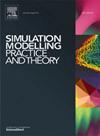Study crowd following behaviors with dynamic groups
IF 3.5
2区 计算机科学
Q2 COMPUTER SCIENCE, INTERDISCIPLINARY APPLICATIONS
引用次数: 0
Abstract
To use the concept of dynamic group to study crowd following behaviors, group related rules considering pedestrians’ movement characteristics under relevant configurations are proposed. A hierarchy of individual and subordinate leader–follower groups is devised. The hierarchy is allowed to alter in the run-time so that groups can be dynamically added or removed. Through this method, crowd following behaviors can be modeled with the concept of group in simulations. Data structures and algorithms are designed in order to implement the proposed method into a GPU-based heterogeneous computing platform. Numerical experiments demonstrate the model’s capability to capture phenomena such as self-organization of pedestrian lanes. By calibrating density-dependent parameters, the simulated speed-density relationship shows consistency with the Weidmann fundamental diagram under conditions dominated by dynamic following behaviors. Since such dynamic behaviors are key factors in crowd flows, this work suggests that dynamic group modeling can provide new insights for transportation researchers studying collective dynamics.
研究人群跟随动态群体的行为
为了利用动态群体的概念研究人群跟随行为,提出了考虑行人在相关配置下的运动特征的群体相关规则。设计了个人和下属领导-追随者群体的等级制度。允许在运行时更改层次结构,以便可以动态添加或删除组。通过该方法,可以用群体的概念对仿真中的人群跟随行为进行建模。为了在基于gpu的异构计算平台上实现该方法,设计了数据结构和算法。数值实验证明了该模型能够捕捉行人车道自组织等现象。通过校正密度相关参数,模拟的速度-密度关系在动态跟随行为主导下与Weidmann基本图一致。由于这种动态行为是人群流动的关键因素,本研究表明动态群体建模可以为研究群体动力学的交通研究人员提供新的见解。
本文章由计算机程序翻译,如有差异,请以英文原文为准。
求助全文
约1分钟内获得全文
求助全文
来源期刊

Simulation Modelling Practice and Theory
工程技术-计算机:跨学科应用
CiteScore
9.80
自引率
4.80%
发文量
142
审稿时长
21 days
期刊介绍:
The journal Simulation Modelling Practice and Theory provides a forum for original, high-quality papers dealing with any aspect of systems simulation and modelling.
The journal aims at being a reference and a powerful tool to all those professionally active and/or interested in the methods and applications of simulation. Submitted papers will be peer reviewed and must significantly contribute to modelling and simulation in general or use modelling and simulation in application areas.
Paper submission is solicited on:
• theoretical aspects of modelling and simulation including formal modelling, model-checking, random number generators, sensitivity analysis, variance reduction techniques, experimental design, meta-modelling, methods and algorithms for validation and verification, selection and comparison procedures etc.;
• methodology and application of modelling and simulation in any area, including computer systems, networks, real-time and embedded systems, mobile and intelligent agents, manufacturing and transportation systems, management, engineering, biomedical engineering, economics, ecology and environment, education, transaction handling, etc.;
• simulation languages and environments including those, specific to distributed computing, grid computing, high performance computers or computer networks, etc.;
• distributed and real-time simulation, simulation interoperability;
• tools for high performance computing simulation, including dedicated architectures and parallel computing.
 求助内容:
求助内容: 应助结果提醒方式:
应助结果提醒方式:


